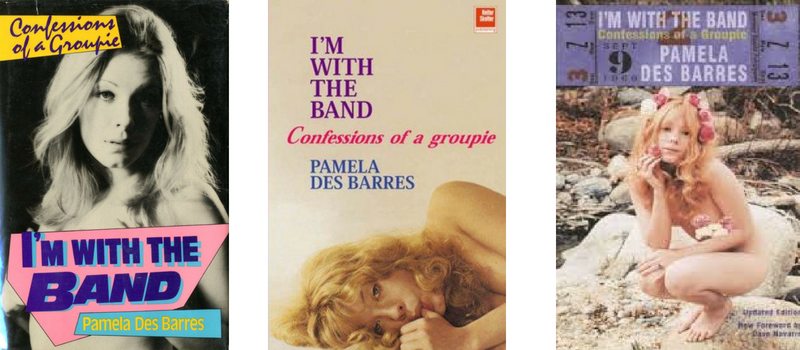Covering Pamela Des Barres

The author of the groupie memoir "I'm With the Band" was a rock star in the 1960s, but it took a few decades for her publishers to treat her like one.
[Updated] The cover for the original publication of I’m With the Band: Confessions of a Groupie is a tip as to how Pamela Des Barres’ memoir was received when published in 1987. A topless Des Barres looked at the camera as if to ask, Think you're next, big boy? while garishly colored angular blocks held the text, a large pinkish purple one obscuring her breasts. It’s a tease that’s impossible to miss, and it indicates how Des Barres’ story and groupies were thought of at the time. A review in Publishers Weekly began, “Fortunately, Des Barres injects humor into these accounts of degradation, which exemplify the subculture of rock music.”
The uncredited reviewer’s choice of the word “degradation” reflected his or her attitude toward sex and the situation because Des Barres’ encounters with Noel Redding, Keith Moon, Jimmy Page, Mick Jagger, and Waylon Jennings—to name a few—are more nuanced and equal than the stereotyped groupie/rock star encounter brings to mind. Much of the story is about the making of Miss Pamela, a groupie on the Sunset Strip in Los Angeles in the late 1960s who was pursued by the British rock aristocracy as she pursued them. She was nominally a rock star herself as a part of the Frank Zappa-produced GTOs, I’m With the Band shows that she is very much her own creation.
Des Barres will be in New Orleans this week, first for a dance party Thursday at Art Klub where she’ll read and be interviewed by Alison Fensterstock, then on Saturday and Sunday, she’ll hold a two-day “femoir”—female memoir—writing workshop, also at Art Klub. (There’s still time to sign up for the latter) Teaching memoir writing has been her gig for the last 18 years, and it is the subject of her most recent book, Let it Bleed: How to Write a Rockin’ Memoir. In it, she presents the process of telling your story as a form of self-examination, sometimes so much so that she jokingly refers to it as “groupie therapy.”
I interviewed Des Barres for a story in The New Orleans Advocate. In our conversation, she spoke briefly of how the dynamics changed by the ’80s when the number of available women gave the bands the kind of power that led to some of the stories of excess in Motley Crüe’s The Dirt. Televised interviews with Des Barres show how that vision of groupiedom is more firmly lodged in the public imagination than her own experience.
I’m With the Band has never gone out of print since the book’s publication, and Des Barres is proud that it’s the first memoir by, as she put it, “a nobody.” She wasn’t a nobody, but the evolution of the book’s cover art reflects changes in how Des Barres, groupies, and sexuality have been thought of. The low point came with a British cover that featured a topless Des Barres sucking her thumb, eyes half-open as if on the nod, but the current one is the best. She is naked in the photo, but with a wreath of flowers clearly integrated into her hair, and there’s nothing peekaboo about the pose. The cover looks like a publicity photo for a muse, and it shows the same belief in Des Barres that other rock star book covers show in their subjects.
Updated June 22, 6:35 a.m.
The text has been updated to include a link to the story in The New Orleans Advocate.






